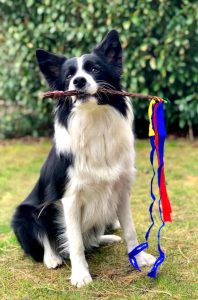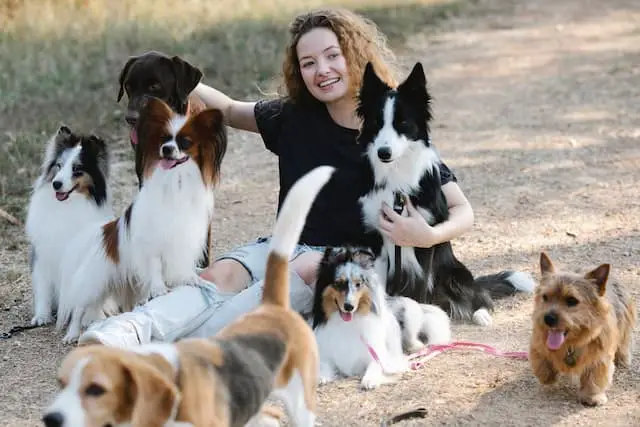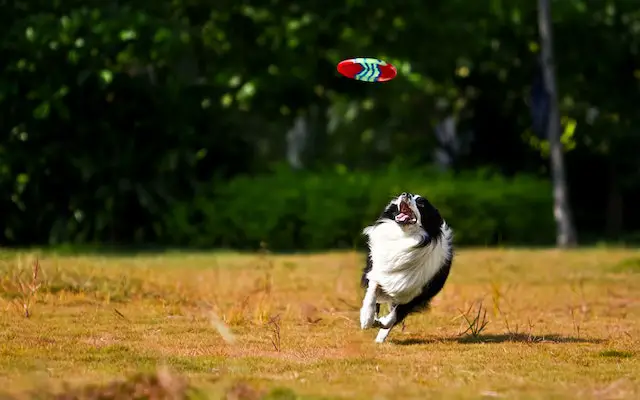Popular dog varieties such as Border Collies and Cavalier King Charles Spaniels each have distinctive appearances, personalities, and other characteristics. Cavalier King Charles Spaniels are smaller, gentler, and more affectionate dogs that were selected for companionship. In contrast, Border Collies are intelligent and active dogs that were bred for herding and other types of work. Both of these breeds are wonderful companion animals for the proper kind of owner.
Comparing Characteristics of Border Collies vs Cavalier King Charles Spaniel
Different characteristics are associated with Border Collies and Cavalier King Charles Spaniels. Border Collies make excellent farmhands mainly because of their endless supply of vitality and stamina. If offered the opportunity, they are willing to put in a full day’s work. This canine will require a household with a busy lifestyle. They have the potential to make wonderful companions for the right people.
On the other hand, Cavalier King Charles Spaniels are known to be friendly, affectionate, and playful with both humans and other dogs. They will show their excitement to participate in any games you come up with, and at the same time, they will gladly lay still by your side if you just want some companionship. This particular variety of Spaniel is exceptionally bright, which makes them simple to train and socialize, resulting in even better manners on their part. It shouldn’t come as a surprise that they are such good candidates for working as a therapy dog for both children and adults.
Here is some basic knowledge about both breeds.
| Description/Breed Name | Border Collie | Cavalier King Charles Spaniel |
| Height | 18 to 22 inches | 12 to 13 inches |
| Weight | 27 to 45 pounds | 10 to 18 pounds |
| Intelligence | High | Average |
| Personality | Wants to be with owner most of the time
Compassionate Hard-headed sometimes Eager to please the owner |
Wants to be with owner most of the time
Compassionate Loves snuggle Eager to please the owner |
| Lifespan | 12 to 15 years | 9 to 15 years |
History of Border Collies and Cavaliers
The working Collie quickly became an invaluable asset for flock owners in the border area between Scotland and England. Without the tireless labor of these dogs, the vast flocks of sheep would have been nearly impossible to manage.
In addition to carefully planned breeding, there were numerous reports of unplanned matings between working Collies, farmers’ dogs, and stray canines in the countryside. Some intentional breeding efforts involved the gundogs and collies owned by gamekeepers. A debate arose regarding whether the gundog-collie cross was more influenced by gundog genes or Collie genes.
The King Charles Spaniel also referred to as the English Toy Spaniel is an English canine. It was originally developed as a lap dog for King Charles II. The King Charles Spaniel is related to the Cavalier King Charles Spaniel and the Blenheim Spaniel and shares many characteristics with them. Since at least the 17th century, when it was first depicted in paintings by Anthony van Dyck and Peter Lely, King Charles Spaniel has existed.
These early canines are believed to have descended from pugs and other toy dog varieties. The origin of the breed’s name derives from the fact that King Charles II (1660-1685) kept several of them as companions. It is uncertain if the breed has existed long enough to be considered a distinct breed or if it is merely a variation of other small spaniels, such as the toy or miniature poodle.
Appearance of Border Collie vs Cavalier King Charles Spaniel
Medium-sized and nimble, the Border Collie has a distinctive black and white coat. It is lower to the ground than other breeds, which aids in its ability to herd sheep. This dog has a double coat that’s distinguished by its black and white color. It’s also water-repellent that is oftentimes straight or curly outer coat. Border Collies may also have coats with a merle pattern. The face of a Border Collie is well-proportioned, distinct (some may even say attractive), and easily recognizable, with ears that occasionally droop forward in an endearing manner.
The Cavalier King Charles Spaniel boasts a magnificent mane characterized by silky, wavy, and feathered fur. This distinctive coat can be found on the ears, torso, legs, and feet, and is of medium length. Cavaliers can be found in several common colors, including Blenheim, which features a rich chestnut hue on a pearly white background. Tricolor Cavaliers have black markings on a white coat, with tan present over the eyes, on the face, and under the tail.
Cavaliers of the black and tan coloration exhibit a combination of black and tan fur. Ruby Cavaliers, on the other hand, display a deep, solid red coat. In addition to their marvelous coats, these dogs possess irresistible faces. Their soft, round eyes have the power to melt hearts, while their adorable noses beckon to be gently stroked. While the breed’s popularity extends beyond its refined appearance, it’s impossible to overlook its distinctive and endearing features, as they are an integral part of the Cavalier’s unique profile.
Size Comparison
The adult Border Collie weighs between 30 and 45 pounds. Fully mature Border Collies are between 18 and 22 inches tall at the shoulder. In contrast, an adult Cavalier King Charles Spaniel weighs 13 to 18 pounds. Fully mature Cavalier King Charles Spaniels measure 12 to 13 inches at the shoulder.
Coats & Colors
In addition to their 24 beautiful colors, Border Collies have two distinct coat types:
- Rough – Border Collies with a rough coat have a medium-length coat that may be feathered and slightly fluffier on the thighs, abdomen, and chest
- Smooth – Smooth-coated Borders have shortened hair all over their bodies and minimal feathering.
Cavalier King Charles Spaniels typically have four distinct coat patterns. Two of these are termed “parti-colors,” while the remaining two are solid colors. Each coat pattern imparts a distinct mode of expression and appearance.
Personality & Temperament of Border Collies vs Cavaliers

Border Collies are energetic and hardworking dogs that thrive in rural settings. However, when confined without adequate exercise or companionship, they can become unhappy and exhibit destructive behavior. This breed demonstrates exceptional intelligence, quick learning abilities, and a strong receptiveness to recognition and rewards.
Due to their herding instincts, they are extremely protective of their family and territory, making them excellent guard canines. They will protect the family’s children. Although they get along well with children and other pets, they can be reserved and even aggressive toward strangers, nipping at their heels in the same way they would at sheep if they were herding.
Despite their small size, the Cavalier King Charles Spaniel possesses a vibrant personality. These dogs are outgoing, energetic, and thrive on social interaction. Their gentle nature drives them to seek nothing more than to please their owners. However, training these dogs requires patience, consistency, and perseverance. Engaging in repetitive training sessions is crucial to achieving desired results.
Family and Border Collies vs Charlies
Border Collies can make excellent family pets; they have been a part of countless families for decades. They have a reputation for being highly intelligent, obedient, and loyal canines who genuinely enjoy pleasing their owner.
Cavalier King Charles Spaniels are widely recognized for their remarkable affection, sociability, optimism, and strong desire to please. They truly thrive in the presence of humans and other dogs, making them well-suited for homes where they won’t be frequently left alone. These delightful dogs excel as family companions and are particularly beloved by the elderly due to their calm and non-demanding nature, without excessive hyperactivity.
Kids
Both the Border Collie and Cavalier King Charles Spaniel are gentle and protective dog breeds around children. The Border Collie is loyal and has a natural instinct to protect its family, making it an excellent watchdog that will keep an eye out for any potential danger.
Similarly, the Cavalier King Charles Spaniel is a friendly and affectionate breed that is known for its gentle nature and adaptability. They are great playmates for kids and can also be a source of comfort and companionship. Whether you choose a Border Collie or a Cavalier King Charles Spaniel, both breeds are loving and protective companions that are well-suited to families with children.
Other People
Border Collies are known to be friendly with people and good family pets. Border Collies are very intelligent, which makes them easy to train. If you take the time to train your dog well, it should be well-behaved and nice most of the time.
Cavalier thrives in a social setting and also, they are extremely devoted and affection-starved. Their attention is not exclusive to their owners. The Cavalier enjoys social interaction. They are what you might call social creatures who enjoy being the center of attention. Excellent with strangers and with children.
They enjoy sitting on any lap and being caressed for as long as you will allow it. Remarkably, the Cavalier gets along with most other domestic pets, including dogs and cats, if they are introduced early and given time to become acquainted.
Dogs & Other Animals

Border Collies as herders, typically do not intend to harm other animals. Once acclimated, this breed is nonaggressive and embraces other pets as playmates. However, many of their herding behaviors can harm other animals or pets. Before bringing another pet into your household, you have to spend enough time and effort to ensure that they got along together. Cavalier King Charles Spaniels and cats can be wonderful friends and coexist peacefully if they are socialized properly and as early as possible.
Behaviour Issues
When deprived of intellectual and physical stimulation, Border Collies have a tendency to engage in behaviors that may cause damage and display obsessiveness. It is important to provide these dogs with suitable mental and physical activities to prevent the development of such challenging behaviors.
King Charles Spaniels on the other hand are prone to separation anxiety and exhibit undesirable behaviors such as barking, whining, clawing, and chewing when left alone; therefore, they require a great deal of human interaction.
Training & Exercise of Cavaliers vs Border Collie

The Border Collie requires daily exercise both mental and physical activities, which can involve a lengthy jog, play sessions, or at least an hour of training. They derive great pleasure from herding, swimming, catching Frisbees, pulling, retrieving, leaping, and tugging. It is important to offer them a range of stimulating activities to fulfill their needs and keep them content.
Collies excel in dog sports such as obedience and agility, which are essential for their overall physical and mental well-being.
Obedience training enhances communication and strengthens the bond between Collies and their owners. Additionally, agility showcases their speed, agility, and teamwork as they navigate through obstacle courses. Participating in these activities ensures that Collies remain active, stimulated, and fulfilled, contributing to their overall happiness and health.
In general, training a Cavalier King Charles Spaniel is very simple. They are extraordinarily intelligent and appreciate interacting with their owners. Additionally, they are quite mild and do not require a great deal of mental stimulation.
Since they enjoy lounging on the couch and strolling through the park, their disposition makes them an excellent option for a home. The training of a Cavalier should begin when it is a puppy, and positive behavior should be rewarded with treats and praise.
Comparing Taking Care & Maintenance of Border Collies vs King Charles Spaniel
Generally speaking, you should clean your Collie’s teeth at least once per week. In addition, a Collie must be bathed every four to eight weeks as part of their care. Typically, this will help in preserving the health and cleanliness of Collie’s coat. Purchase a hairbrush, comb, and nail shears for your Collie. Additionally, trim their nails every four to six weeks as well.
If you intend to maintain the beauty of your Cavalier King Charles Spaniel, you will not be required to perform extensive maintenance.
In fact, the breed standard mandates that they be kept as close to their natural state as possible. Consequently, their long feathery fur, particularly on the ears and tail, will require regular grooming or combing. You may need to spot-trim certain areas, such as the long hair on their feet.
Consider binding their ears back with a scrunchie or headband during mealtimes, particularly if you plan to feed them with a wet or raw diet.
Grooming
The Border Collie has a medium-length double coat that can be either rough or silky. It is comprised of a coarse outer coat and a soft undercoat. Regular maintenance is crucial, and it is recommended to brush their coat on a weekly basis to prevent tangles.
Although active Border Collies may have naturally worn down nails, it is essential to check and trim them on a regular basis. This will help maintain their feet. Additionally, you should pay attention to their dental hygiene and brush their teeth at least 2x or 3x per week.
Cavalier Spaniels necessitate a moderate amount of hygiene maintenance. The Cavalier King Charles Spaniel is a canine breed that sheds moderately. Their luxuriously long coat requires brushing on a daily basis in order to prevent tangles and mats. In an effort to keep their coats silken and glossy, bathing them every four to six weeks is recommended.
Additionally, monthly nail trimming, ear cleaning, and under-paw care should be performed. Preferably, you should visit a professional groomer three to four times per year, so your dog gets the best treatment.
Shedding
Almost every dog sheds, but a Border Collie might catch you off guard. Due to their double coat, they shed significantly more than other canines that do not have a double coat. If you can’t bear having fur all over your home during summer and autumn, you might want to consider a dog that sheds less.
Cavalier King Charles Spaniels shed and drip moderately. Regular brushing and bathing can lessen shedding throughout the year. During shedding season, Cavalier owners should use a good vacuum and lint roller to handle excess hair.
Health of Charlies vs Border Collie
The Border Collie is a relatively robust breed with few genetic problems. However, as with all purebred canines, they are more susceptible to specific health issues that can be inherited. It is ideal to purchase your puppy from a reputable breeder because there are numerous types of Border Collies in the world, and some of them carry diseases or disorders that others do not.
Because of this, it is imperative for future owners to be aware of this breed’s potential health problems. Hip dysplasia, epilepsy, heart disease, and eye disorders, including cataracts and retinal atrophy, are some of the most common that affect Border Collies. Due to the Border Collie’s intelligence and high activity levels, it is essential to keep them in shape through regular exercise and weight control.
Cavalier King Charles Spaniels have a reputation for being friendly, devoted, and affectionate, so it may not always be apparent when they are ill. Fortunately, many of this breed’s health issues have observable symptoms, so you can easily provide the necessary medical care.
Mitral Valve Disease, Episodic Falling Syndrome, and Syringomyelia are the most common health concerns for Cavalier King Charles Spaniels. There is no cure for every condition, but regular exercise and monitoring will go a long way toward ensuring that your furry companion lives a long and healthy life.
Life Span
The typical lifespan of a Border Collie ranges from 10 to 17 years, with most dogs falling closer to the middle of this range. While it is uncommon for Border Collies to live up to 17 years, it is indeed possible. On average, these dogs live for at least 12 years, but certain genetic lines may be prone to health issues that can shorten their lifespan to around 10 years. It is important to consider various factors that can influence a Border Collie’s lifespan.
The Cavalier King Charles Spaniel is known to live up to ten years. Official estimates range from 9 to 14 years. This depends on numerous variables, including genetics, health care, and the environment.
Diet & Nutrition
A high-quality, protein-rich food should be given to a Border Collie to support their high activity and muscle mass. Their healthy skin and joints will also benefit from a diet that is high in omega-3 fatty acids.
Providing a suitable diet for your Border Collie according to its life stage is crucial. During puppyhood, it is recommended to feed them a high-quality puppy formula until they reach 12 to 18 months of age. Afterward, transitioning to adult dog food is advised. Border Collies are typically not prone to obesity due to their high activity levels, and feeding them twice a day is sufficient to meet their needs.
There is no set feeding quantity for Border Collies because each food has a unique caloric value. Do not presume that you should give your pet the same amount of food if you switch brands or flavors. Always follow the manufacturer-recommended feeding guide and consult your veterinarian to validate the correct feeding amount for the new food.
To support the health of their bones and joints, Border Collies can benefit from the addition of a supplement. This helps maintain their cartilage, especially considering their active lifestyles. Additionally, incorporating a supplement can contribute to a glossy and healthy coat.
Like all dogs, the diet of a King Charles Spaniel should consist of animal proteins and carbohydrates for energy, essential vitamins and minerals, and omega fatty acids for a nourished coat and skin. Optimal nutrition for King Charles Spaniels can be achieved through premium dry food specifically formulated for small breeds, as it provides the necessary daily requirements for this particular breed.
Cheap, generic foods are not recommended for this breed because they are primarily composed of “filler” ingredients that do not promote long-term health.
Common Health Issues of Border Collies vs Charlies
Your Border Collie can live at least 14 years if he is in good health. There are one or two dog diseases that are more common in this breed. It is smart to know what could go wrong, even though it is very rare if the dog is cared for properly.
- Primary epilepsy – also called unexplained epilepsy. This affects dogs younger than 5 years old. Idiopathic epilepsy is more likely to happen in some types of border collies, but no genetic link has been found. Your dog’s seizures may need long-term treatment because of electrical problems in the brain. Even though dogs can’t be cured of epilepsy, they can be treated with medicine from your vet, letting them live a healthy life.
- Hip dysplasia – Collies are more likely to get hip dysplasia, which is a genetic disorder that causes the hip socket to form wrongly. Because of this, your pet may become lame and have painful arthritis. After a nap, your Collie will have trouble getting up. It happens in many kinds of dogs, but it happens more often in bigger breeds.
- Collie eye anomaly – this is a genetic disease that can cause your dog to go blind. In the United Kingdom and the United States, 70 to 97% of collies are affected. By looking at your dog, your vet will figure out how bad the problem is. It is common in a dog’s first year, but it can be stopped if it is found early.
Cavaliers are susceptible to mitral valve disease, which can result in congestive heart failure. Each of the four chambers of the heart has a one-way valve to prevent the backflow of blood. One of these valves is the mitral valve, which can develop a leak over time and cause a cardiac murmur. Mitral valve leaks can cause murmurs in puppies as early as 4 years old.
Your companion develops congestive heart failure, a chronic cough, and a lack of endurance. A veterinary cardiologist may need to be consulted in order to recommend a course of treatment. Before making a recommendation, the veterinarian will evaluate your pet’s health and lifestyle. In addition to the luxating patella and eye problems, the Cavalier may face additional health problems.
When the kneecaps move out of place, this is called patellar luxation. It could be bad enough to make the dog’s leg limp, but it can be fixed with an anti-inflammatory drug or even surgery.
Cost of Charlies vs Border Collie
The initial investment for a Border Collie puppy is typically $1,000. Border Collies have a price range that generally falls between $600 and $1,250. On the other hand, the cost of a Border Collie can fluctuate anywhere from $100 all the way up to $5,000.
On average, purchasing a young Cavalier King Charles Spaniel will set you back $2,410. The Cavalier King Charles Spaniel usually sells for between $1,800 and $3,000 depending on the breeder. However, the price of a Cavalier King Charles Spaniel can range anywhere from $300 to $7,995 depending on the breeder.
Puppies

It is essential to begin training a Border Collie puppy as soon as possible. The sooner they are trained, the better. The breed enjoys being in control and will exhibit dominance if its owners do not demonstrate leadership.
When training a Border Collie, a compassionate, yet firm tone and positive reinforcement are highly effective. If they are punished or frightened during training, their sensitive nature may cause them to withdraw.
As working dogs by nature, Border Collies enjoy routines. If you deviate from the routine to which your dog has become accustomed, he may become frustrated and exhibit aggressive or destructive behaviors. Keep in mind, when training a Border Collie, that this breed’s heightened intelligence allows them to comprehend more than you might expect. They can recall schedules and commands with ease.
Cavalier King Charles Spaniel puppies must be socialized in order to develop their confidence and personality.
Bringing a Cavalier puppy into your life is similar to bringing a baby into your household. Before your pup arrives, you must puppy-proof your house. To keep your Cavalier safe and out of trouble, store away all breakables, valuables, and potential dangers. You can also install gates to block off restricted areas of the home.
Cavaliers possess innate hunting instincts and may exhibit a tendency to chase scents or animals. Your Cavalier puppy will also require other essential items such as:
- Dog food
- Bowls
- Toys
- Treats
- Dog bed
- Crate
- Collar and leash
- Grooming equipment
Cavaliers have strong hunting instincts, which may prompt them to chase scents or animals. When bringing a Cavalier puppy into your home, it’s crucial to have the necessary supplies, including:
- Toys
- Treats
- Dog food
- Bed
- Crate
- Collar and leash for walks
Additionally, grooming equipment is essential to keep them clean and well-maintained.
For the first few days, keep your Cavalier puppy peaceful and happy because being in a strange place with strange people can be upsetting for them. If there are children in the house, they should not chase or bark at the canine. Spend as much time as possible with your dog to make him or her feel secure and promote attachment. You can expect your Cavalier to accompany you everywhere, including the bathroom, due to his or her dependent personality.
Finding Breeders & Centers
There is a good chance that rescue organizations and animal shelters have Border Collies accessible for adoption. Unfortunately, there are some owners who gave up their dogs because they are unable to provide the high level of care and activity that is required by the breed.
If you think a Border Collie would be a good fit for you and your lifestyle, the Border Collie Society of America is a great place to start looking for one. Their breeder recommendation directory includes information on how to get in touch with breeders and rescue organizations located all over the United States.
When purchased from a breeder, a Border Collie puppy could cost anywhere from $700 to $2000. Expect to spend more when purchasing from a breeder, as adoption fees are typically only a few hundred dollars.
Adopting a Cavalier King Charles Spaniel from a rescue costs between $150 and $600 on average. However, the majority of shelters provide adult canines. Consequently, depending on your budget, you must choose between raising puppies purchased from a breeder or adopting an adult canine at a lower cost.
Additionally, shelter dogs receive appropriate veterinary care. Therefore, adopting a Charles Spaniel saves you money on veterinary expenses such as vaccinations and other necessary health tests.
Conclusion
It can be challenging to choose the right dog breed for your lifestyle and preferences, but knowing the characteristics and needs of each breed is critical. Both Cavaliers and Border Collie are amazing breeds that are extremely intelligent, loyal, and affectionate. Border Collies are medium-sized, highly energetic dogs that require a lot of mental and physical stimulation. Cavaliers are a smaller, more laid-back breed that needs moderate exercise and is excellent with children.
If you appreciate spending time outside and giving your dog plenty of exercise and mental stimulation, a Border Collie may be a better fit. A Cavalier Spaniel, on the other hand, maybe a better fit if you prefer a smaller, lower-maintenance dog who is content to relax with you on the couch. Finally, it boils down to personal preference and lifestyle.
No matter what breed you choose, it’s important to give your pet the care, love, and attention it needs to be happy and healthy. Do your research and find out what each breed needs before making a choice. The health and happiness of your pet should always come first.


